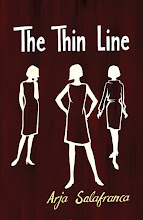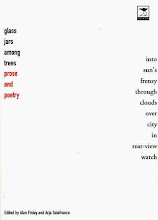
An edge is the most exhilarating point for a story to place itself. Ask any reader. We don’t need cliff-scrabbling above a literal precipice; masters (and mistresses) of the form can hollow out spaces of mystery and risk beneath the most prosaic inner or outer landscape. But what we do ask, as readers, is that the threshold matter somehow and that we are surprised and, perhaps, even changed when the story crosses it.
The Edge of Things, then, is an enticing title and a flexible one too, stretching to cover all manner of brinks. Characters cross the endlessly fascinating boundary between innocence and experience, naivety and self-knowledge, one sharing his first kiss at the company picnic, another beheading her first chicken.
What would infidelity look like? one story wonders, while another shows us what looks like cheating but turns out, in the flick of a needle, to be bridal branding instead. Worlds collide: matter-of-fact house renovations clang against soul-exchanges in one story while in another an empty house invites a range of intruders, from teenage lovers to lowering-the-tone buyers to symbolic creatures, recalling District 9, that challenge notions of inside and out.
Liesl Jobson’s “tips for super pics” apply with wit and pain to parent-child relationships, tracing shifts that the photographer protagonist catches out of the corner of her eye while her lens is trained elsewhere. Beatrice Lamwaka writes about a schoolgirl who wants to win a race on sports day. She has, after all, trained hard, fleeing rebel soldiers who abducted her. “I outran them so that’s an A+ for me. If anyone needs more practice in athletics, I’m sure it’s not me.”
Sometimes, an edge is sharp enough to draw blood. Then there’s literary edginess, fun with texts, intertextuality. Iconoclasm (“I don’t like Coetzee”) meets homage, for example, in Jeanne Hromnik’s exploration of new-South-African father figures both lecherous and pathetic. Perd Booysen amuses himself, and us too, with the device of the discovered journal, inadmissible as historical evidence because of its fictional finesse.
In David wa Maahlamela’s playful bus ride across the fiction/non-fiction frontier, we meet both Wordsetc and its editor, Phakama Mbonambi. In the optimistic view of the narrator, also called David, writers who describe lived experience “know exactly the impression they are intending to give their readers”. But this is perilous terrain for less adept scribes.
An event that bit your heart for real needs just as much construction on the page as a situation you make up from scratch. You can’t refer to that day, you must weave it, as Bernard Levinson does in “Tokai”. We have no idea whether the story draws on his life or his imagination or some alchemical meld of the two. What matters is that he shapes place, time and action so fully, so deftly that, like the narrator, we are moved by the mysterious intensity of the last scene.
The Edge of Things is in every sense a mixed bag. Alongside Levinson’s story, gems include Salafranca’s unforgettable image of a mother in an iron lung and Pravasan Pillay’s characters, dialogue and spicy small-canvas family drama.
Silke Heiss’s “Don’t Take Me for Free”, arguably Best in Show, nimbly outstrips our expectations. Like its trucker-clown narrator, Vonny, the story “was built to change”.
In Vonny’s extended appeal to her lover, “All-I-Have, Azar”, the language is as elating as the ride across ostrich and canola country in a bright-eyed van “with its massive, roaring heart and load continuing to doer ’n gone”.
The collection’s subtitle – South African short fiction – proposes that we read the stories as a kind of national sampler. (In a one-off slip, the introduction makes an unwarranted claim to be presenting writing “on our continent”.) Clearly, South African fiction has moved beyond the imperative to be earnest, political or even particularly South African. Mischief is now acceptable story territory, while Fred de Vries’s chilling tale could take place in almost any big city and Aryan Kaganof’s junkies claim that Amsterdam may as well be Durban, “there’s no fucking difference. Bars are the same everywhere. Drugs are the same everywhere.” But it is also true that, as per Hromnik, “the past is hungry”.
Several stories tackle a mix of race and privilege, either head-on or obliquely. In “Telephoning the Enemy”, for instance, Hans Pienaar crosses the “what if ?” line for an intriguing revisit of apartheid-era violence.
Solitude, as Salafranca notes in the introduction, features in many of the stories. We glimpse various anxious, closed, self-referential worlds. A man sits at a café table in the last story, telling himself consoling untruths and inking “NARCISSIST” into his crossword puzzle as he fends off contact.
What feels like a limitation, though, looking back over the collection, is neither inner landscapes nor low spirits (excellent fiction fodder) but rather a sense of stasis in some of the stories, a single note struck and held, Act 1 from curtain up to curtain down.
For these writers and for all the rest of us, Jenna Mervis’s story offers advice. Her protagonist “mentions nothing of … the fingernails of trees that have begun to tear at her corrugated roof in the night”. She looks for “a sign that … that the dangers outside have become manifest”. But by the end (and this won’t spoil it for you), she steps off the edge of the deck and plunges into the veld. Why not, writers? Instead of tamping down tension, why not let it explode? Approach the edge. Plunge. Leap.
REVIEWER: A Zimbabwean filmmaker and writer, Annie Holmes has published short stories in the US and Zimbabwe and a short memoir,Good Red, in Canada. She co-edited, with Peter Orner, Hope Deferred: Narratives of Zimbabwean Lives.
(Published in Wordsetc, Third Quarter 2011)





.jpg)

No comments:
Post a Comment